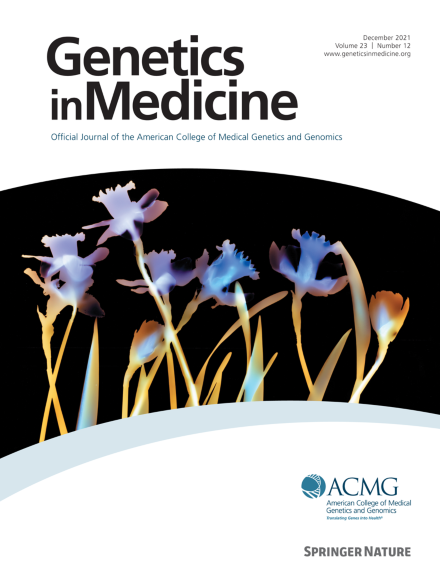Improved diagnosis of patients with rare diseases through the application of constrained coding region annotation and de novo status
IF 6.2
1区 医学
Q1 GENETICS & HEREDITY
引用次数: 0
Abstract
Purpose
Identifying the pathogenic variant in a patient with rare disease (RD) is the first step in ending their diagnostic odyssey. De novo (Dn) variants affecting protein-coding DNA are a well-established cause of Mendelian disorders in patients with RD. Constrained coding regions (CCRs) are specific segments of coding DNA that are devoid of functional variants in healthy individuals.
Methods
We evaluated the diagnostic utility of incorporating combined Dn/CCR status into the variant prioritization cascade for patients with RD that have undergone genomic sequencing. Using the Genomics England 100,000 Genomes Project v12, we selected 3090 trios that have undergone diagnostic evaluation and been analyzed with an advanced Dn identification pipeline.
Results
Our analysis shows that the diagnostic rate increased from 71% in the full cohort to 87% for Dn/CCR variants. Of note, manual evaluation of the Dn/CCR variants from undiagnosed patients with clinical follow-up revealed a diagnosis for 13 further patients. This outcome increases the diagnostic rate for Dn/CCR variants to 91% and suggests that the application of this metric can prioritize diagnostic variants in undiagnosed patients.
Conclusion
We demonstrate the potential clinical utility of performing bespoke Dn analyses of patients with RD and for incorporating CCR information into the filtering cascade to prioritize pathogenic variants.
通过约束编码区标注和新生状态的应用提高了罕见病患者的诊断。
目的:确定罕见病(RD)患者的致病变异是结束其诊断过程的第一步。影响蛋白质编码DNA的从头(Dn)变异是RD患者孟德尔疾病的一个公认的原因。约束编码区(CCRs)是健康个体中缺乏功能变异的特定编码DNA片段。方法:我们评估了将联合Dn/CCR状态纳入变异优先级联的诊断效用,用于已进行基因组测序的RD患者。使用Genomics England 100,000 Genomes Project v12,我们选择了3,090个经过诊断评估的三人组,并使用先进的dna鉴定管道进行了分析。结果:我们的分析显示,Dn/CCR变异的诊断率从整个队列的71%增加到87%。值得注意的是,通过临床随访对未确诊患者的Dn/CCR变异进行人工评估,发现了另外13例患者的诊断。这将Dn/CCR变异的诊断率提高到91%。这表明该指标的应用可以优先考虑未确诊患者的诊断变异。结论:我们证明了对RD患者进行定制Dn分析以及将CCR信息纳入过滤级联以优先考虑致病变异的潜在临床应用。
本文章由计算机程序翻译,如有差异,请以英文原文为准。
求助全文
约1分钟内获得全文
求助全文
来源期刊

Genetics in Medicine
医学-遗传学
CiteScore
15.20
自引率
6.80%
发文量
857
审稿时长
1.3 weeks
期刊介绍:
Genetics in Medicine (GIM) is the official journal of the American College of Medical Genetics and Genomics. The journal''s mission is to enhance the knowledge, understanding, and practice of medical genetics and genomics through publications in clinical and laboratory genetics and genomics, including ethical, legal, and social issues as well as public health.
GIM encourages research that combats racism, includes diverse populations and is written by authors from diverse and underrepresented backgrounds.
 求助内容:
求助内容: 应助结果提醒方式:
应助结果提醒方式:


